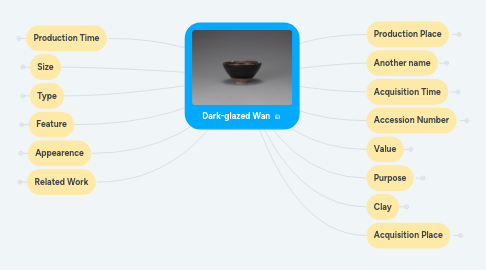
1. Production Time
1.1. Most of the dark-glazed wan were produced during the Southern Song period
1.1.1. Southern Song
1.1.1.1. Southern Song is a later part of the Song Dynasty (1127-1279). After the riverside of the Zhenggang River in 1127, the capital was placed in Iman, South China, and Southern Song was rebuilt.
1.1.1.1.1. Song Dynasty
2. Related Work
2.1. Fukutomijoshi
2.1.1. Fukutomijoshi It is a painting of the director of the Tokyo National Museum in Japan in the 19th century, and two dark-glazed wan are drawn side by side on the shelf in the room, suggesting the popularity of Tenmoku(dark-glazed wan) that continued to later generations.
3. Appearence
3.1. Most of the dark-glazed have blackish glaze coagulating and flowing down the outer side.
3.1.1. Glaze
3.1.1.1. Glaze is a glass powder that covers the ceramic surface to create gloss, color, or pattern, and when the glaze is coated on the surface of the bowl and melted at an appropriate temperature, the bowl hardens and removes the absorption of gas. Silicone and silica, the main ingredients of glaze, can be obtained from silica, kaolin, silica, etc., and can also be obtained from wood materials.
3.2. Some parts have fallen off in the guyeon and gup of the wan.
3.2.1. Guyeon
3.2.1.1. Guyeon means the entry of a container(e.g. bowl, bottle, pot, etc).
3.2.2. Gup
3.2.2.1. Gup is connected with pottery bottom, and is made for supporting pottery.
4. Feature
4.1. About 60 pieces of the dark-glazed wan made in Geonyo were found in the Sinan shipwreck.
5. Type
5.1. Dark-glazed
5.1.1. It means glaze of a dark color, commonly referred to as pottery made from that glaze.
6. Size
6.1. H. 6.4cm
6.2. The diameter of my entry 12.2cm
6.3. The diameter of the floor 3.9cm
7. Production Place
7.1. Geonyo in China(bokgeonseong geonyanghyeon sugiljin )
7.1.1. Geonyo is located in Jenyang-gu, Fujian Province in China.
7.1.1.1. Geonyeo is located in Sugiljin, Konyang County, Fujian Province, China.
8. Another name
8.1. Tenmoku
8.1.1. Tenmoku means a teacup similar to a mortar that drinks powdered tea used in tea ceremonies.
9. Acquisition Time
9.1. Excavation began in October 1976.
10. Accession Number
10.1. Sindo 1544
11. Value
11.1. Japanese national treasures and important cultural properties.
11.1.1. n Japan, four pieces of dark-glazed wan produced in Geonyo are designated as national treasures and important cultural properties.
12. Purpose
12.1. It's for drinking tea.
12.1.1. White tea
12.1.1.1. White tea is popular in Song Dynasty
12.1.1.2. Tea lovers liked white tea.
12.1.1.2.1. dark-glazed wan was greatly welcomed by tea lovers
12.1.2. Wan
12.1.2.1. Wan is a bowl used to hold tea
12.1.2.2. it goes up diagonally from the bottom toward guyeon, and its location is large compared to its height.
13. Clay
13.1. Clay of pottery is a particle of soil that makes pottery. It is made by mixing clay, kaolin, feldspar, silica, and lead stone and grinding finely or filtering them out of water. The ingredient ratio varies depending on the product, and these days, it can be purchased at the clay factory, and there are celadon, white porcelain, buncheongto, pottery, combination soil, and Sancheongto.
13.1.1. The color of the clay used in Dark-glazed Wan
13.1.1.1. yellowish-brown
13.1.1.2. black
13.1.2. Clay of pottery is a particle of soil that makes pottery. It is made by mixing clay, kaolin, feldspar, silica, and lead stone and grinding finely or filtering them out of water.
13.1.3. The ingredient ratio varies depending on the product, and these days, it can be purchased at the clay factory, and there are celadon, white porcelain, buncheongto, pottery, combination soil, and Sancheongto.
14. Acquisition Place
14.1. Sinan shipwreck
14.1.1. Sinan shipwreck became known in 1975 when a fisherman caught six pottery in a net while fishing. The fisherman reported the pottery to the Sinan-gun office in January of the following year, and excavation began in October of that year. In the sea, a large number of artifacts for foreign trade, including celadon made during the Yuan Dynasty, were excavated.
14.2. This relic was found in Sinan.
14.2.1. Different artifacts were obtained from the same place.
14.2.1.1. Garlic-shaped bottle
14.2.1.2. Crane-pattern pillow
14.2.1.3. Black dot-patterned jar
14.2.1.4. Water buffalo-shaped yeonjeok
14.2.1.5. Lion-shaped incense burner
14.2.1.6. Lotus&fish-patterned wan
14.2.1.7. Dragon-pattern prunus vase
14.2.1.8. Kettle
14.2.1.9. Celadon large vase with applique chrysanthemum design
